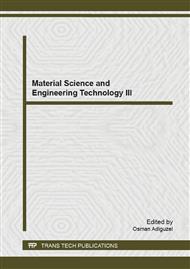p.212
p.217
p.225
p.229
p.233
p.238
p.245
p.249
p.252
The Impact of Generalized Stacking Fault Energy on the Mechanical Properties of Shuffle Dislocation in Zigzag Single-Walled Carbon Nanotubes
Abstract:
The calculation of generalized stacking fault energy for covalent materials exists several relaxation methods. And the modification factor of the restoring force should be different for different relaxation. In order to study the impact of generalized stacking fault energy on the mechanical properties of dislocations, the dislocation energy, Peierls barrier and Peierls stress of shuffle dislocation in zigzag single-walled carbon nanotube (SWCNT) under different modification factors are studied by the improved Peierls-Nabarro (P-N) theory. It is found that the misfit energies decreased, and the strain and total energies increased with increasing of the modification factor Δ. With the modification factor Δ of the restoring force changes from -0.2 to 0.5, the dislocation energy changes from 17.4eV to 19.3eV. The Peierls barriers Ep and σp Peierls stresses increased first and then decreased and the results are not as same as we thought. The impact of generalized stacking fault energy on mechanical properties of dislocations is not so simple as we thought and need to be further studied.
Info:
Periodical:
Pages:
233-237
Citation:
Online since:
April 2015
Authors:
Price:
Сopyright:
© 2015 Trans Tech Publications Ltd. All Rights Reserved
Share:
Citation:


